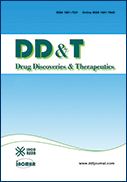Volume 11, Issue 2
Displaying 1-10 of 10 articles from this issue
- |<
- <
- 1
- >
- >|
Original Articles
-
2017Volume 11Issue 2 Pages 54-63
Published: April 30, 2017
Released on J-STAGE: May 30, 2017
Advance online publication: April 25, 2017Download PDF (1325K) -
2017Volume 11Issue 2 Pages 64-69
Published: April 30, 2017
Released on J-STAGE: May 30, 2017
Advance online publication: April 30, 2017Download PDF (1050K) -
2017Volume 11Issue 2 Pages 70-77
Published: April 30, 2017
Released on J-STAGE: May 30, 2017
Advance online publication: April 30, 2017Download PDF (591K) -
2017Volume 11Issue 2 Pages 78-83
Published: April 30, 2017
Released on J-STAGE: May 30, 2017
Advance online publication: April 30, 2017Download PDF (1344K) -
2017Volume 11Issue 2 Pages 84-90
Published: April 30, 2017
Released on J-STAGE: May 30, 2017
Advance online publication: March 19, 2017Download PDF (784K) -
2017Volume 11Issue 2 Pages 91-97
Published: April 30, 2017
Released on J-STAGE: May 30, 2017
Advance online publication: April 14, 2017Download PDF (964K) -
2017Volume 11Issue 2 Pages 98-103
Published: April 30, 2017
Released on J-STAGE: May 30, 2017
Advance online publication: March 19, 2017Download PDF (699K)
Brief Reports
-
2017Volume 11Issue 2 Pages 104-109
Published: April 30, 2017
Released on J-STAGE: May 30, 2017
Advance online publication: April 24, 2017Download PDF (895K) -
2017Volume 11Issue 2 Pages 110-114
Published: April 30, 2017
Released on J-STAGE: May 30, 2017
Advance online publication: April 24, 2017Download PDF (984K)
Case Report
-
2017Volume 11Issue 2 Pages 115-117
Published: April 30, 2017
Released on J-STAGE: May 30, 2017
Advance online publication: March 19, 2017Download PDF (209K)
- |<
- <
- 1
- >
- >|
